Twinkle
Toes The Toe Walker
--or--
My
Baby Walks on Their Toes—What Can I Do?
by Trisha Roberts
Do you have a little “Twinkle Toes” that Walks on their Tip Toes? Then this article is for you!

Beautiful If You Are a Ballerina, But.......

It is important to
understand normal ambulation to better understand the problems associated
with Toe Walking. Children usually begin walking around the celebration of their first Birthday. The
beginning walking pattern for a child is typically with their feet flat, legs
open (wide base of support) and hands in the air for balance like a mini Tight
Rope Walker (Hands at High Guard). Over
the next several months the Beginning Walker should develop a more mature gait
pattern that consists of three phases:
Heel Strike or Contact Phase, Foot Flat or Mid-Stance, and Push-Off or Propulsion Phase. The heel of each foot should
strike the floor first, followed by a foot-flat stance position as the child moves
forward and places their weight on the foot, and then pushing off on the toes
as the child propels themselves forward.
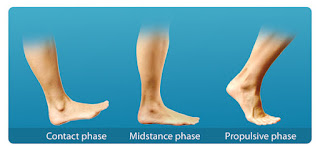 |
| Phases of Gait |
As this walking pattern develops the child
will also start to swing their arms reciprocally with their legs, or in other
words, the right arm and left leg move forward and alternate with the left arm
and right leg, enabling them to perform a fast walk. By 18 months of age, or after
a child has been walking for 6 months, they should consistently be striking the
ground with their heels when walking. Children will sometimes rise up on their
toes, but this should not be their primary position in standing or when moving.
Children generally develop the ability to walk on tip toes at about 3 years old, but they should always be able to get their feet flat on the floor at any age and should never be using Tip Toe walking as their primary method of locomotion. The philosophy that “they will grow out of it” is not a good philosophy to adopt.
 |
| Walking Consistently on Tip Toes is NOT Typical |
In my work as a clinician, I am frequently asked to treat children who
have been toe walking for months, and in some cases, years. It is extremely difficult to undo years of
toe walking, especially if the muscles and bony structures of the feet and
ankles are tight or contractured. Toe Walking changes the child’s entire body—posture, balance, bio-mechanics (how a child uses their body to move), and strength.
Walking consistently on tip toes can be an indication of a
more serious problem and should be discussed with your Pediatrician. Toe
walking can be caused by Cerebral Palsy, high muscle tone, or weakness. It is frequently associated with Autism or
sensory issues (children who have increased or decreased tolerance to sensation). Sometimes there is not a specific cause for the toe walking and
it is referred to as Idiopathic Toe Walking or ITW. Most physicians will refer your young child to
an Early Intervention Specialist—A Physical Therapist that specializes in
working with children birth to three years old.
Your Physical Therapist will have lots of ideas, activities, massage,
and exercises for you to work on with your child. It is vitally important that you follow your
therapist’s treatment plan. Exercise and braces (night time and/or day time
use) are typically the “First Line of Attack” when addressing issues
surrounding Toe Walking. In severe cases or in cases of Toe Walking that have
not responded to exercise and bracing, other, more aggressive treatment options
might be considered that may consist of Serial Casting, Botox Treatment, or
surgical procedures to lengthen tight/shortened muscles and tendons.
The following are activities that I use in my Physical Therapy practice that I find fun and effective:
- Have your child stand on a Wedge or Incline while playing at the refrigerator, mirror, or
wall.
 |
| Standing on an Incline Promotes Heels Down |
With their feet in an “uphill” position, their heels are in a better
position to weight bear. You might try
using a re-positionable marker board or other toy to encourage play in this
position.
- Have your child sit on a Scooterboard and propel themselves forward using their heels.
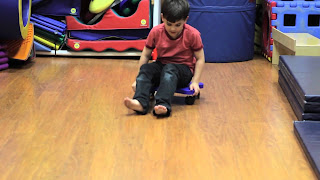 |
| Scooter Board Encourages Heels Down and Feet Up Position |
This activates and strengthens the
Dorsiflexors of the foot (muscles responsible for lifting the foot). Using the feet in this position counters the
Plantarflexors (muscles responsible for pointing the foot down) and are the
muscles that get tightened in Toe Walkers.
- Pedaling a Tricycle can
also be useful in getting a child to use the foot with their heel down and in a
flattened position. Most children by 2 or 2 1/2 years old can ride a small
tricycle. Younger children can benefit from a Ride On Toy that they propel "Flintstone-Style".
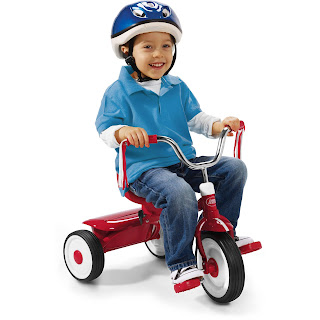 |
| Feet Flat on a Tricycle |
- Play games that encourage your child to Walk Backward.
“Simon Says” take
10 steps backward.
“Simon Says” take
10 steps backward.
- Do a dance that requires lots of heel stompin’!
- Take a walk at a park and look for Climbing Hills. It is
difficult to walk uphill using just your toes!
- Kicking
a ball is an action that requires standing on one leg and swinging
through with the other leg.
 |
| Balance on One Foot While Kicking a Ball |
It is very difficult to kick while standing on tip toe!
- While your child is standing, lift one of their feet or tilt your child in standing so that they
have to weight bear on a flat foot on the supporting leg.
- Have your child sit on
a small step stool with their feet flat on the floor during a play activity.
Place a puzzle or other game on the floor and
have them lean forward to play with the game while making sure that their heels
stay in contact with the floor. Have your child sit on the step stool and then ask them to stand up while you hold their feet flat on the floor.
- The heels of our feet should make contact with the floor when
we are in a Squat position.
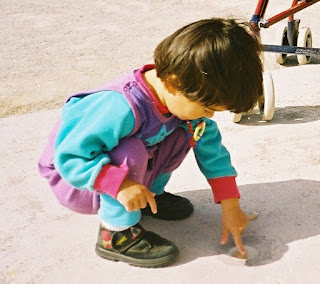 |
| Squatting in Play Gets Heels Down |
 |
| Squat Position for Play |
 |
| Making Playing in Squat Position Fun |
Scatter Blocks or Legos on the floor. Have your child squat to pick up a block and walk
(heels down!) over to the ‘Construction Zone’ and add to their architecture.
Repeat until their tower is complete or they run out of blocks!
- Get a pair of child-sized Swim Flippers.
 |
| Walking in Swim Flippers |
Have your
child walk with the flippers on their feet—impossible to walk on your toes!
- Animal Walks.
Everyone squat down and “Walk
like a Duck”! Make it a fun game—put
out food for the ducks (crackers or other small snacks) in different places and
have your child Duck Walk to each ‘feeding station’.
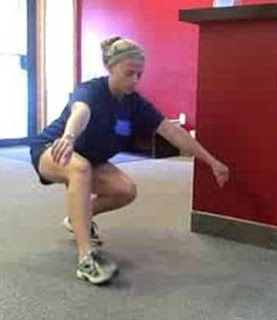 |
| Duck Walk |
"Walk like a Crab"--feet flat, tummy toward the ceiling, and hands behind the back and on the floor.
 |
| Crab Walking |
"Walk like a Bear"--feet flat on floor, hands on floor, bottom in the air.
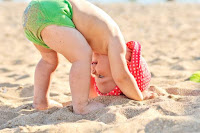 |
| Bear Walk |
 |
| Feet and Hands Down--Bear Walk |
 |
| Improve Gait-- Bear Walk |
"Walk like a Penguin"--toes up and waddle forward!
 |
| Toes Up and Walk Like a Penguin! |
"Jump Like a Frog"--Squat down with feet flat and hands next to your body and then 'spring' forward like a frog, landing on flat feet again.
 |
| Jump Like a Frog! |
Your therapist will have other suggestions, but this should get you started walking along the road with heels down!
Author: Trisha Roberts
www.proeducationaltoys.com
www.proeducationaltoys.com
As always, we welcome any suggestions, questions, comments or concerns!
Copyright © 2016 TNT Inspired Enterprise, LLC,
All rights reserved.
Unauthorized duplication is a violation of
applicable laws.




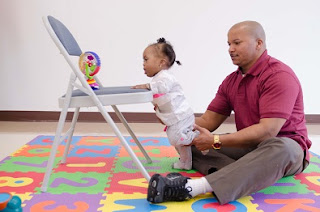

No comments:
Post a Comment